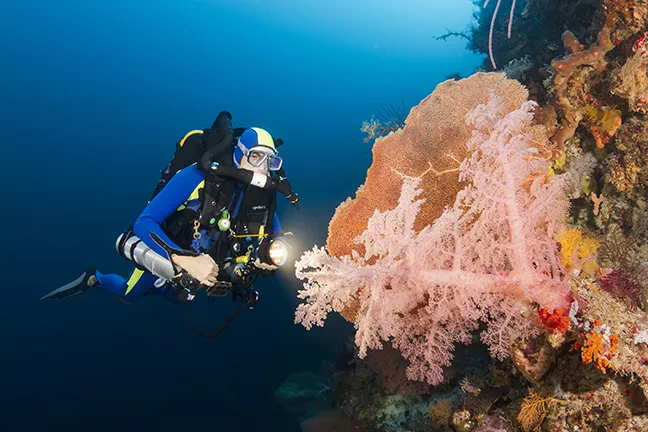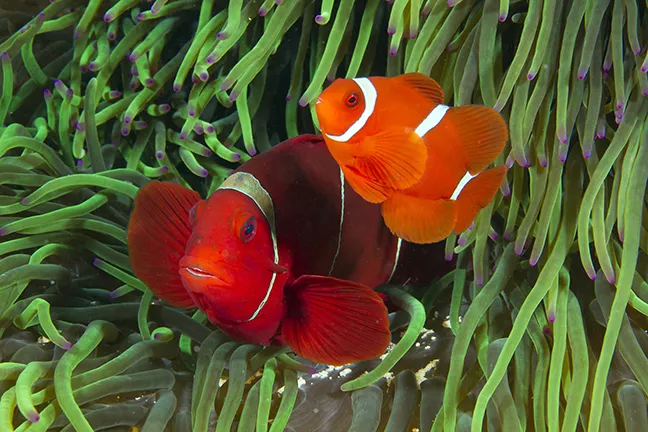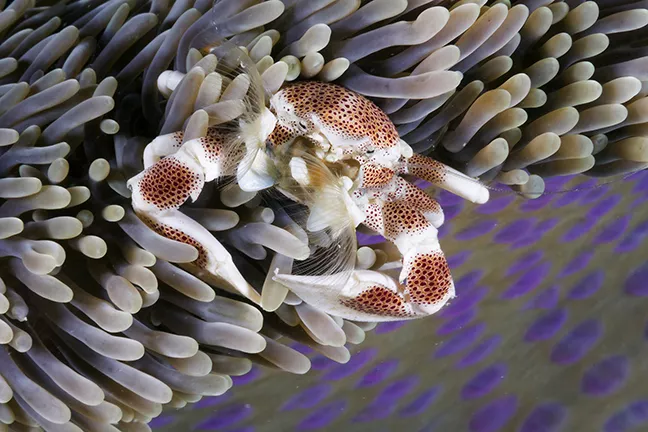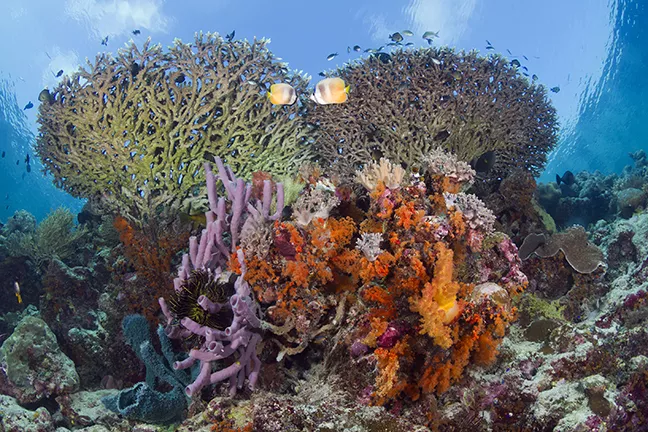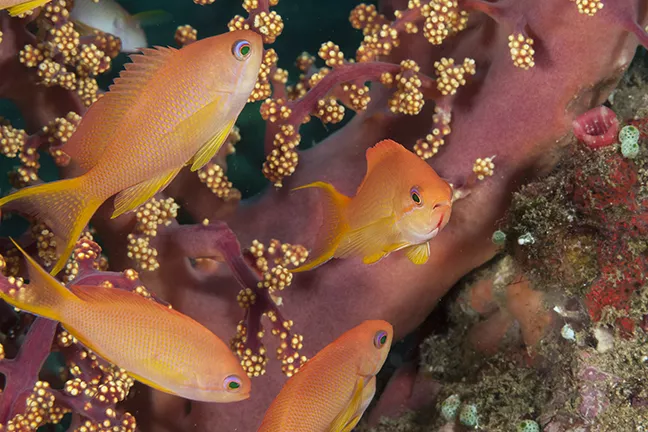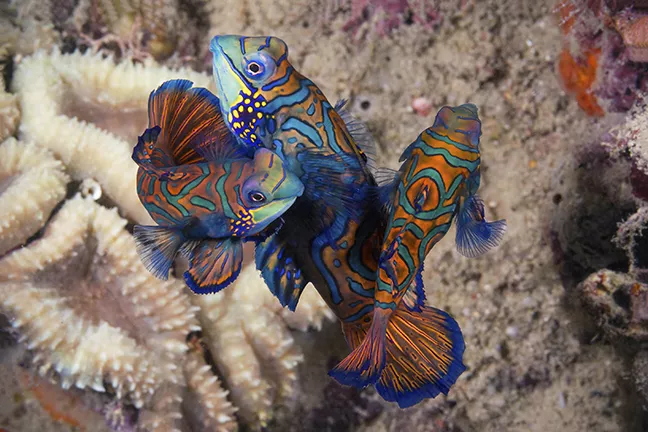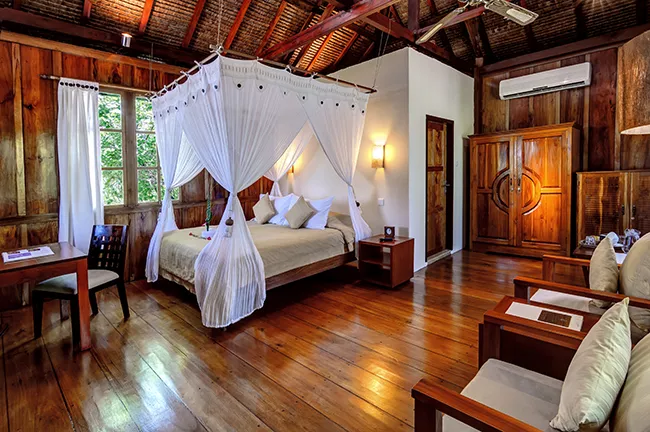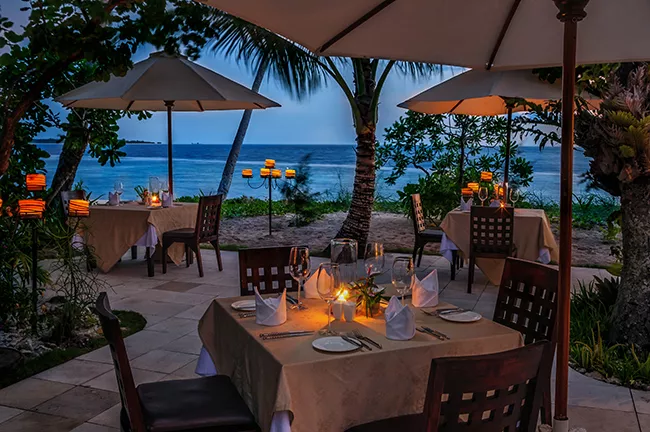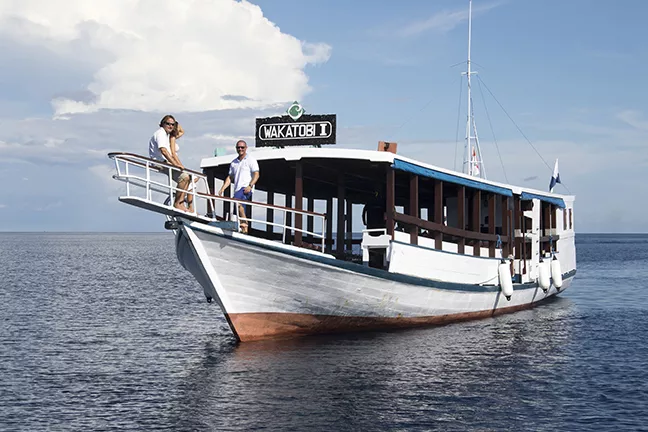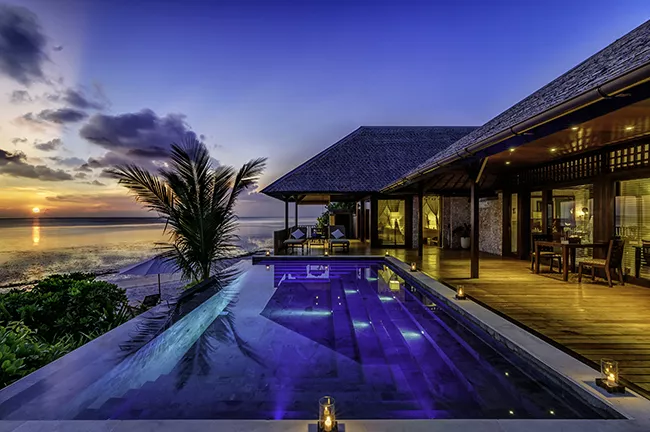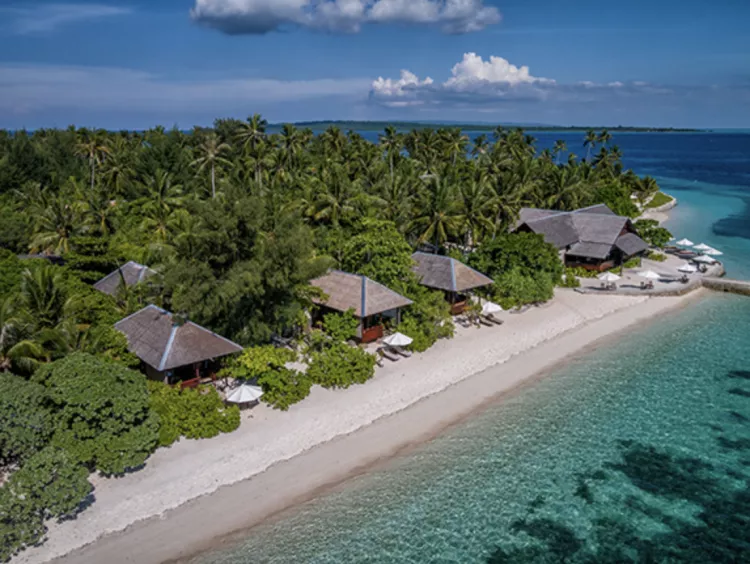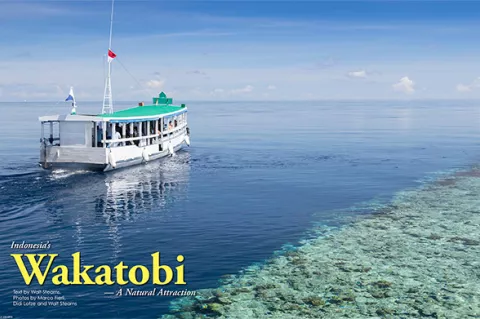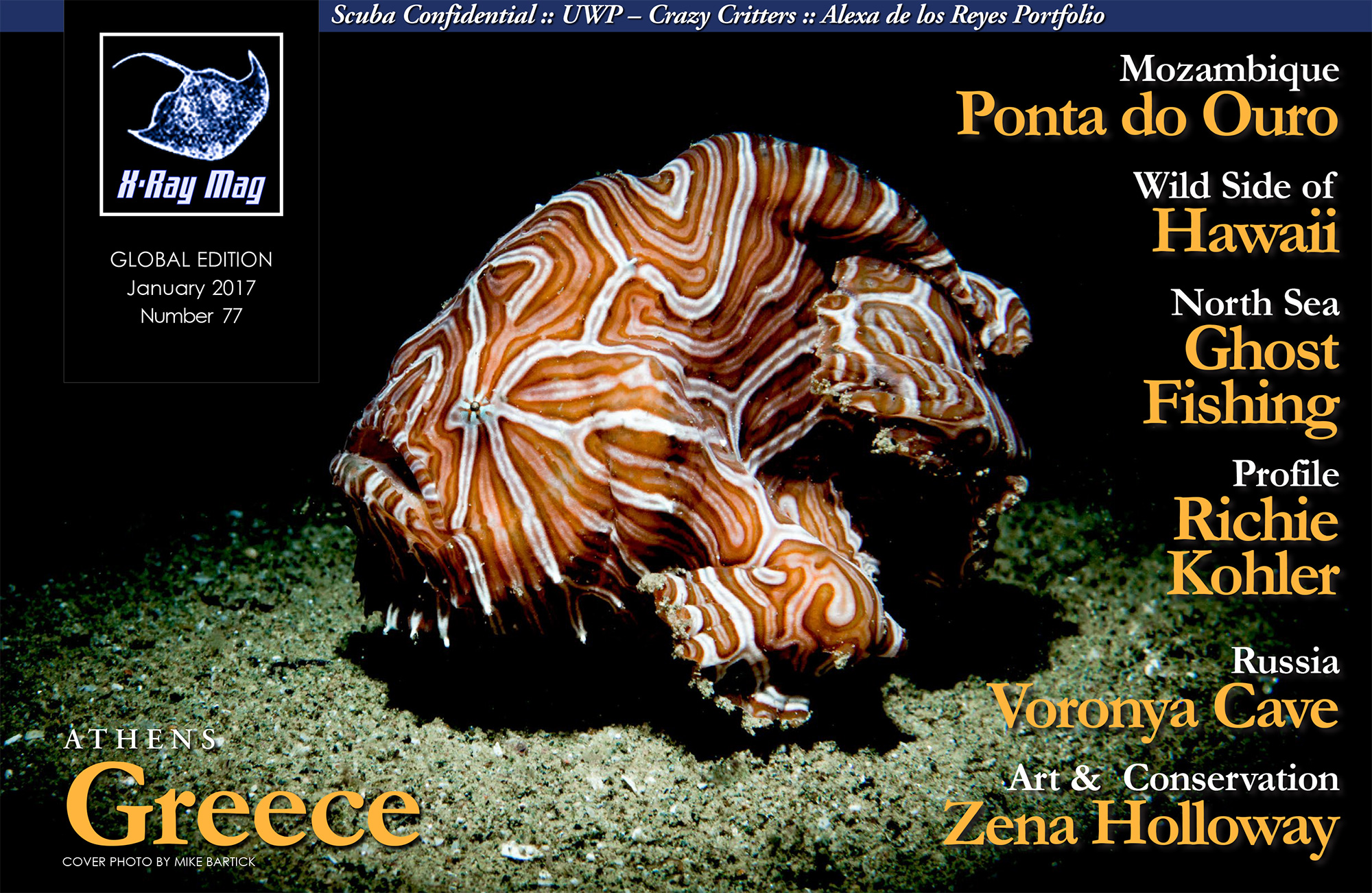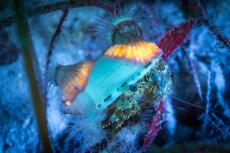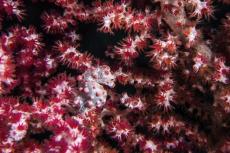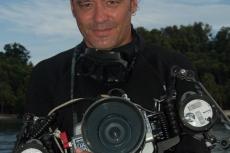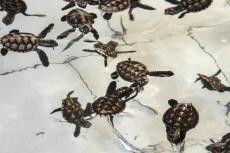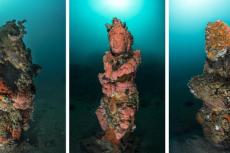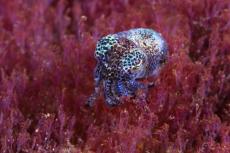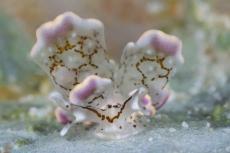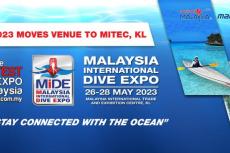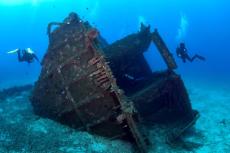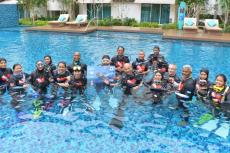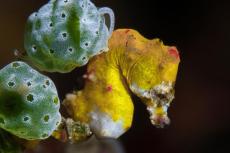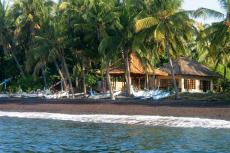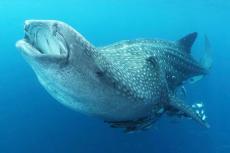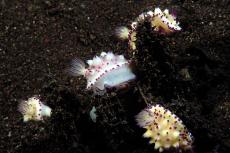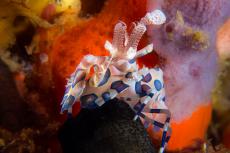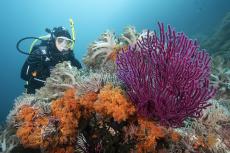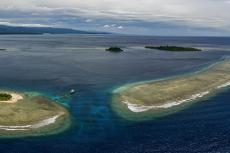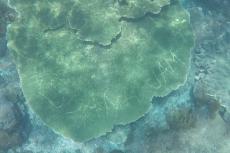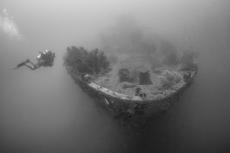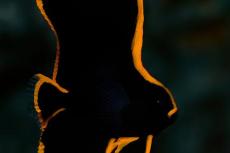Off the tip of Southeastern Sulawesi, Indonesia in the Banda Sea, Wakatobi Dive Resort offers an unforgettable blend of pristine, protected reefs with sustainable luxury.
Contributed by
Dive sites that offer unusual or dramatic underwater topography have always intrigued me. And from what I had been hearing, the site known as Blade was a prime candidate to add to my “favorites” list.
During the boat ride to the site from Wakatobi Dive Resort our dive guides described the Blade formation as a series of small seamounts running in succession, with two of the summits rising to within five meters of the surface. Bridging these two structures is a very narrow, elongated ridge. The profile this creates when viewed from either side, and at a distance (the water is that clear), resembles the serrated edge of a knife; hence the name.
Blade is one of the most distant sites visited by the resort’s dive boats. Unlike the majority of the sites that are within a few minutes of the dive center, this one required a boat ride of almost an hour. But as soon as I entered the water, I immediately realized that the wait had been well worth it.
Seen from above, Blade’s profile almost defies description. I have had the opportunity to dive a great number of pinnacle formations, but this was something entirely different. This impressive natural formation resembles a massive medieval battlement, averaging just seven meters thick while running several hundred meters in length. On both sides of the Blade, the walls drop precipitously into the deep blue. It was enough to take my breath away.
Rising above a vivid backdrop of chromatic blue, every facet of this grand rampart was covered in coral. Adding to Blade’s unique and highly picturesque topography is a comprehensive collection of giant sponges, sea fans and soft corals, providing fantastic photo opportunities no matter which side you decide to swim.
Underwater Nirvana
While I might question the validity of Jacques Cousteau having actually called the Wakatobi islands an “Underwater Nirvana,” what I am certain of is that the description does fit. The majestic formation that is Blade is just one of many within the largest barrier reef system in Indonesia; a place where pristine reefs teem with the most bio-diverse collection of marine life in the world.
Above and beyond
The reasons behind Wakatobi Dive Resort’s ongoing appeal are obvious. Guest have access to pristine coral reefs and walls slightly more than a stone’s throw away from a resort property providing sumptuous accommodations, gourmet level dining, spa services and an attentive staff that know your name from the first day of your arrival. It’s those special touches that go above and beyond what you come to expect that make this resort stand out.
When Wakatobi began taking in guests some 20 years ago, the operation’s infrastructure was more akin to a dive lodge than a resort. At that time, all aspects of operation from dive locker to kitchen, along with guest accommodations, were all housed in the Longhouse. Through the years, Wakatobi grew up, leaving such Spartan amenities behind to become what could be described as luxury dive resort that combines eco-friendly design with operating principles that continues to set industry standards for guest service.
Accommodations now includes what Wakatobi calls their Ultimate, Gold Standard and Essentials selections. The Essential category includes the resort’s nine Palm Bungalows, which feature classic Indonesian design blended with a comprehensive list of amenities.
Located just off the beach amidst palm trees and other tropical plants, the Palm Bungalows offer comfortable air-conditioned rooms with large beds and furnishings hand-crafted from splendid hardwoods. From the verandah you can savor nature’s music in the form of birdsong and gentle waves lapping on the shore, while breezes rustle through the trees. And, at the same time, have wi-fi internet access.
At the other end of the accommodation spectrum, are Wakatobi’s four villas. Set on a low ledge just above the beach, each villa is more than double the size of the Palm Bungalows, providing the opulence and spacious comfort of a five-star retreat with an unobstructed, yet private view of both the ocean and Wakatobi’s spectacular sunsets.
Upping the ante, Villas One and Two are two bedroom, two bath models that feature a large deck with outdoor spa shower and plunge pool overlooking the ocean.
In between these choices are resort’s 15 Ocean Bungalows. Like the villas, these face the shoreline, and provide the same indoor amenities as the Palms plus a few additional additions. The most noticeable is a spacious Asian spa-style outdoor shower with tall privacy walls adjoined to the bungalow’s indoor bathroom.
Creature comforts are not the only area in which Wakatobi excels. Never before have I seen such a large and well-equipped restaurant kitchen in as remote a location as Wakatobi. Every meal is prepared by internationally-trained chefs with a talent for creating an blend of delicious Indonesian and international cuisines. And the deserts are, well let me put it this way: Don’t count on your wetsuit getting any looser during the trip!
The “pool” is open
Wakatobi is first and foremost a dive resort, so it is no surprise that the diving infrastructure is first class in all respects. The Dive Center is a full-service facility staffed by a diverse and highly professional group of instructors, dive masters and guides who together speak over nine languages, from English to German and to even Japanese. This group can provide everything from basic instruction and refresher courses to advanced and technical training. The center offers a full range of Mares brand of equipment in their rental department maintains a large cache of 12L (80cu ft) aluminum cylinders along with a fair number of 10L (63cu ft) and 15L (100cu ft) aluminum cylinders fitted with both DIN and standard yoke valves.
For basic diving activities, divers have the option of air or 32% nitrox supplied by two state-of-the-art nitrox membrane systems, fed by multiple water-cooled Bauer compressors. For the technical crowd, there are higher nitrox blends available, including pure oxygen, along with helium on special request for trimix.
Wakatobi also caters to the silent diving crowd, they can not only provide rebreather divers with 8/12 grade (797) Sofnolime but enough O2, dil and bailout bottles for up to 21 CCR divers at a time. Close to a third of these cylinders for rent are Faber 2L and 3L steels with inline rebreather valves, with the rest being 2L (13 cu ft) and 3L (19 cu ft) aluminum models fitted with DIN K-valves. For off board bail, options include 4.5L (30 cu ft) and 5L (40 cu ft) aluminums. Divers needing something larger can choose the aforementioned 12L (80cu ft) and 15L (100cu ft) aluminums.
Underwater photographers are provided with ample onboard storage space and dedicated rise tanks on boats, along with a climate-controlled room at the Dive Center with ample workbench space and numerous recharging stations in both 220 Volt and 110 Volt.
Daily diving activities begin with two-tank morning boat excursions that return guests to the resort in time for lunch. Guests have the option of making an additional single-tank afternoon boat dive, or enjoying unlimited shore diving on the house reef, with dawn to dusk taxi boat support. Night dives by boat are scheduled according to demand.
Each diver is provided with a dedicated storage and staging area. When the day’s plan includes, for example, the two-tank morning and night dive, your gear will be there and ready to dive when you step on board. This goes for just about everything else, including camera equipment—why carry it when the staff will eagerly do it for you?
Another nice touch is that it is common for the boats return to the jetty in between the first and second dive, giving divers a chance to stretch their legs, and giving late risers to catch the second dive. This flexibility, combined with the House Reef, allows guests to create an almost custom boat and shore dive schedule.
In my book, the thing that can break or make a great dive experience is the boat. Wakatobi’s core fleet of dive boats are five enormous vessels measuring 23 meters in length. Locally crafted, each boat is designed specifically for diving with a copious amount with deck space with ample seating and ample space for camera equipment, no matter the size.
While they may not be fast, they are impressively stable on the water, providing an enhanced comfort level that is further elevated by a full roof that provides overhead protection from sun and rain. Though these boats could easily hold two dozen passengers, Wakatobi likes to ensure that guests have plenty of elbowroom by limiting the number of divers and/or snorkelers on board from 10 to a maximum of 14.
While a few sites like Blade, Coral Hill and Fish Wall may require longer boat ride from the resort, the majority are less than a half-hour boat ride away. Conditions at the sites themselves are mostly benign, and even more timid and less athletic divers will enjoy themselves, as there are rarely big seas to contend with. Instead, a collection of surrounding reefs and sheltering islands create consistently calm to mild sea states at dive sites, and deliver brilliant visibility in the 30-meter-plus range.
There are more than 40 sights regularly visited, each engaging in their own way. Many offer profiles that start a few feet from the surface with abrupt contours toppling down into the depths. The most striking are the collection of totally vertical profiles on sites near Sawa Island. Here, you will find walls that rise as shallow as knee-deep and plummet in vertical faces that reach well below 150 feet. With reef contours of this nature, it is easy to perform a series of extended multi-level dives without going into decompression.
Expect every boat dive to run 70 minutes in length, but you always have the option to end the dive sooner. Spending the latter portion of dives off gassing in the shallows can often be the most interesting part, as the tops of the reefs are just as vibrant as they are deeper down. The shallows are home to a parade of macro-size critters—from blind shrimp with their ever-watchful guardian gobies, to more flamboyant subjects like nudibranchs and broadclub cuttlefish.
For those who are new to Indonesian waters, or who simply wish to see all the wonders of the reef, I would strongly advise following the guides. The Wakatobi dive crew is especially adept at locating the more cryptic forms of marine life, including the four species of micro-size pygmy seahorses that live in these waters. In addition to being astute hunters, guides are always at the ready to lend assistance when needed.
One of the little personal acts I have seen the guides provide is to assist underwater photographers who are trying to shoot a subject in places where corals can be easily damaged. Guides will position themselves as human tripods, providing a steadying grip that allows the photographer to focus entirely on the subject without fear of contacting the reef.
Even if you are not a photographer, Wakatobi’s dive guides are just as attentive, taking every step to ensure the quality of your of your experience both in and out the water. The dive staffs are equally respectful of guests who prefer a bit more autonomy. Thus, if buddy pair wants to explore at their own pace, they are allowed the freedom to do so within the safe range of their personal experience and training. During the surface interval, in addition to snacks, water and beverages like coffee, tea or hot chocolate, guests are given refreshing hand towel infused with water and lemon grass. Having one those offered at the end of a 70-plus minute dive on a beautiful, pristine reef affirms that life is good.
The House Reef
In addition to the boat dives, there is Wakatobi’s famed House Reef, which is available to divers and snorkelers between 5:00 a.m. and 10:00 p.m.. Accessible from both the beach and the property’s pier, which spans 80 meters from the shoreline to the reef’s drop-off, the House Reef offers a topography ranging from inshore grass beds and shallow coral gardens to a drop-off with a precipitous face.
At the edge where these two interfaces meet, the reef takes a sudden plunge from snorkeling depths straight down more than 50 meters into the blue. Down the wall’s face, divers will find a wall perforated by clefts and overhangs, decorated with a dazzling array of hard and soft corals. Between these two realms is a sufficiently large and diverse range of subject matter to keep even the most avid enthusiast captivated for hours on end.
Over the course of a single dive, without even needing to venture more than nine meters on either side of the pier, I have found up to seven different species of anemone fish. The reef’s two-meter deep plateau is also home to a healthy population of small bluespotted stingrays, pipefish, octopus, nudibranchs and more living amongst the finger coral formations and grass beds.
Macro photographers with an interest in invertebrates will be especially pleased by the diversity of animals that can be found on this reef during twilight and evening hours. Divers with good air consumption will easily be able to make many of the dives here last for 90 minutes or more from the Pier and back again.
For buddy teams and single divers with solo diver certification, the resort also offers a taxi boat service to ferry divers to more distant portions of the House Reef.
The taxi service operates during daylight hours, and will even take guests to the neighboring site of Turkey Beach for a truly memorable drift diving experience as you utilize the current to bring you back to the pier.
For all these reasons, Wakatobi’s House Reef has received numerous accolades and awards from magazines and websites such as Trip Adviser, which has called it the “world’s best house reef dive.” I have even dedicated a piece exclusively to it on my own site: UnderwaterJournal.com. Yes, it is that good.
When you add it all up, you are looking at one of the most pristine and bio-divers coral reefs systems in the world, home to more than 600 species of coral, 3,000 varieties of fish, with an even greater number of invertebrates, all just a stone’s throw from luxurious accommodations and delicious meals. Would I come back here again? Well, I have been here three times already, if that tells you anything. ■

